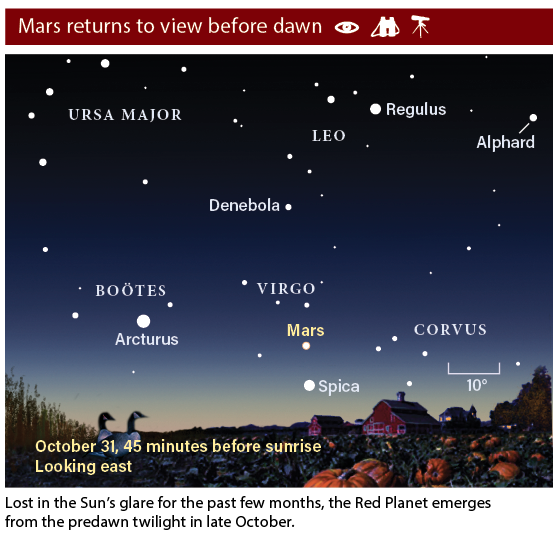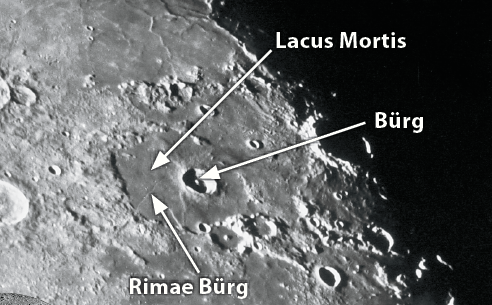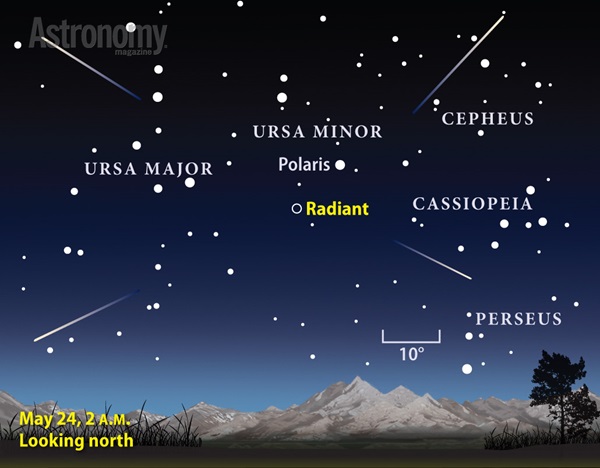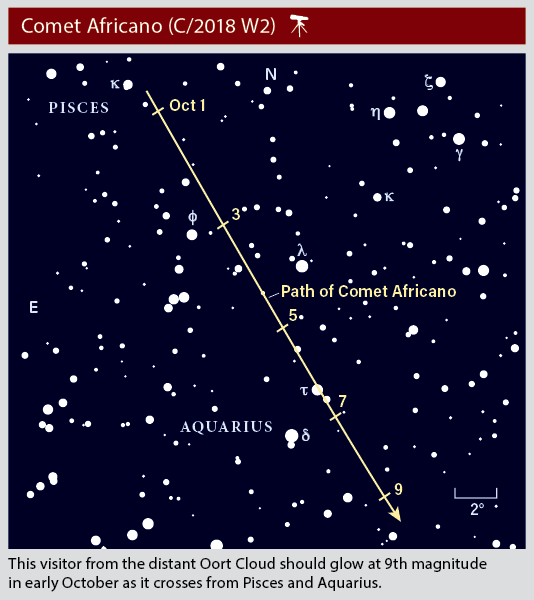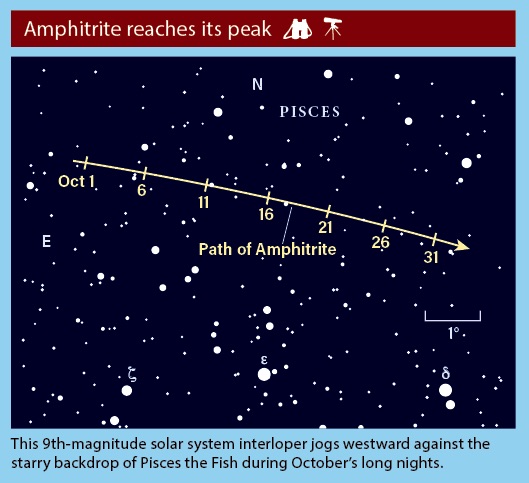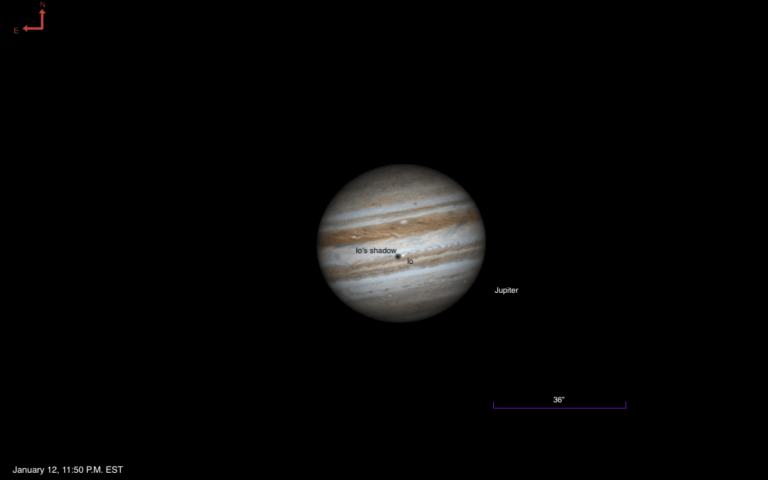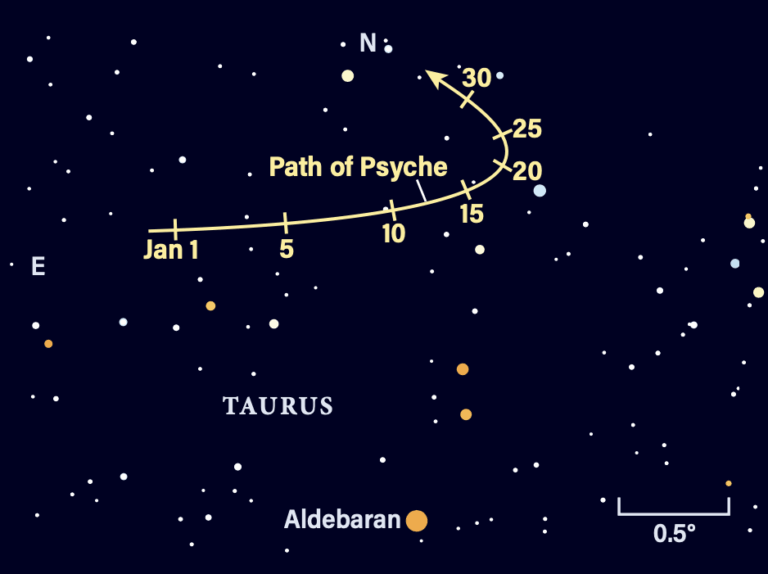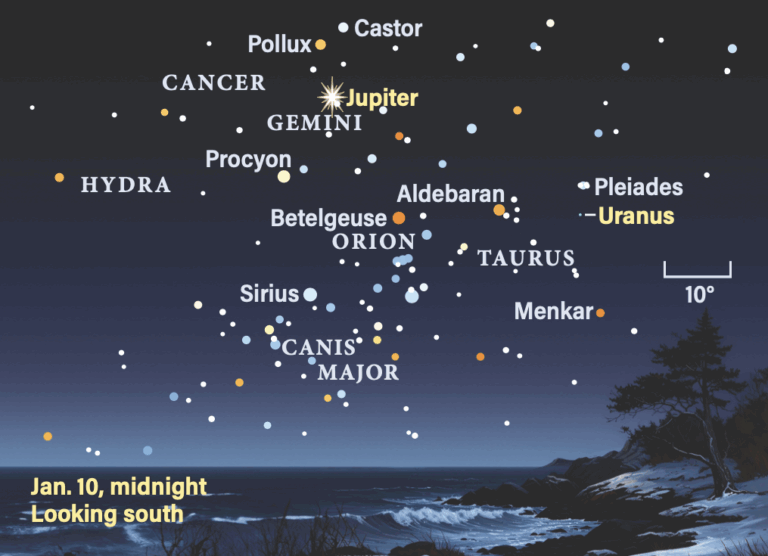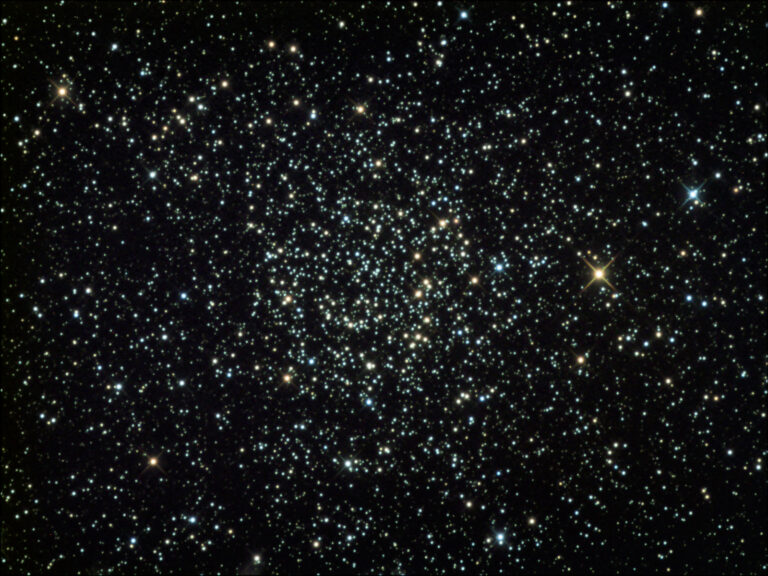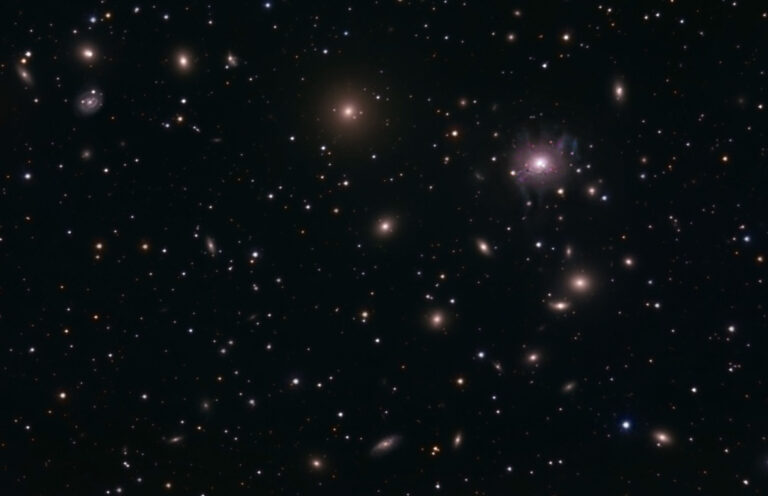You’ll need to look low in the southwest after sunset to see Mercury and Venus. Venus shows up more easily because it gleams at magnitude –3.8 in mid-October. It then stands only 2° high a half-hour after sundown, however, so you’ll need a haze-free sky and unobstructed horizon to spot it.

Bringing the universe to your door. We’re excited to announce Astronomy magazine’s new Space and Beyond subscription box – a quarterly adventure, curated with an astronomy-themed collection in every box. Learn More >>.
Use Venus as a guide for finding Mercury. At greatest elongation October 19, the innermost planet lies 25° east of the Sun and 7° to Venus’ left. If you place Venus at the right edge of the field through your binoculars, you should see its magnitude –0.1 neighbor near the field’s left edge.
While you may struggle to locate the two inner planets, the solar system’s gas giants pose no problem. Jupiter shows up as a brilliant point of light in the gathering darkness. On October 1, the magnitude –2.0 world stands 20° above the southwestern horizon an hour after sundown and doesn’t set until 10 p.m. local daylight time. Unfortunately, it dips lower with each passing day, and drops below the horizon at 8:30 p.m. by month’s end.
Jupiter resides among the background stars of Ophiuchus. Although none of the Serpent-bearer’s stars rivals Jupiter’s luster, the waxing crescent Moon gives it a run for its money twice this month. On October 3, Luna appears 2° to the planet’s upper left; one lunar month later, on the 31st, a noticeably skinnier crescent stands 5° to Jupiter’s upper left.
Jupiter’s low altitude leaves a narrow window in late twilight and shortly after nightfall to get crisp telescopic images. Any scope delivers pleasing views of the world’s dynamic atmosphere. The gas giant’s disk spans 35″ in mid-October. That’s plenty big enough to reveal two dark equatorial belts, one on either side of a brighter zone that coincides with the planet’s equator. Any instrument also reveals Jupiter’s four bright moons, which change positions from night to night.
The ringed planet shines at magnitude 0.5, besting the Archer’s brightest star by a factor of three. Saturn’s yellow glow stands out nicely between the constellation’s Teapot and Teaspoon asterisms, just east of the Milky Way’s star-studded bulge. The scene looks magnificent with the naked eye or binoculars from under a dark sky.
But make sure to target Saturn through a telescope. Any instrument shows the planet’s 16″-diameter disk surrounded by a majestic ring system that spans 37″ and tips 25° to our line of sight. The large tilt provides an exquisite look at the rings’ structure, revealing the dark Cassini Division that separates the outer A ring from the brighter B ring.
Speaking of viewing angles, Saturn reaches quadrature October 7. If you were to draw a line from the Sun to Earth and then to Saturn, it would form a 90° angle. To an observer, quadrature means the shadow cast by Saturn falls as far east of the planet as possible and hides a noticeable section of the rings’ farside. The effect gives the planet a distinct 3D look that lasts for several weeks.
Saturn boasts several moons within reach of amateur telescopes. The brightest is 8th-magnitude Titan, which shows up through any scope. You can find it north of Saturn on October 1 and 17 and south of the planet on the 9th and 25th.
A 4-inch instrument pulls in four more satellites. Tethys, Dione, and Rhea are the easiest to find. All three lie closer to Saturn than Titan and circle the planet in less than a week.
Iapetus proves a bit trickier. This outer moon glows at 10th magnitude when its bright hemisphere faces Earth at greatest western elongation the night of October 1/2. It then lies 8.5′ from Saturn and has no nearby landmarks to point you in its direction. It dims to 11th magnitude by the time it passes 1.3′ north of the planet on the 22nd.
Magnitude 7.8 Neptune glows too dimly to see with the naked eye, but it shows up nicely through binoculars. The planet lies in eastern Aquarius, in the same field of view as 4th-magnitude Phi (ϕ) Aquarii. This star lies about 15° southeast of Aquarius’ distinctive Water Jar asterism.
Neptune appears 0.7° west-southwest of Phi on October 1. The planet’s westward motion carries it to a position 1.3° west-southwest of the star by month’s end. If you target Neptune through a telescope, you’ll see its 2.3″-diameter disk and subtle blue-gray color.
Uranus lies opposite the Sun in our sky the night of October 27/28. At opposition, the planet rises around sunset and sets near sunrise, so it remains a tempting object all night. Opposition also brings Uranus closest to Earth, so it shines brightest and looms largest when viewed through a telescope. Still, Uranus changes appearance slowly — it remains at magnitude 5.7 and its disk spans 3.7″ all month.
The ice giant glows brightly enough to spot with the naked eye from a dark viewing site. The key is knowing precisely where to look. Unfortunately, the faint background stars of southern Aries the Ram don’t offer much help, so it’s best to start with binoculars.
Uranus resides along a line connecting Aries’ brightest star, magnitude 2.0 Hamal (Alpha [α] Arietis), with magnitude 3.8 Alpha Piscium in neighboring Pisces. The two stars lie 21° apart, and the planet appears 1° closer to Alpha Psc. Don’t confuse Uranus with the similarly bright star 19 Ari, which stands 3° north and slightly east of the planet. Once you find the ice giant with binoculars, try to see it without optical aid.
A telescope delivers splendid views of Uranus because it lies high in the sky. From 40° north latitude on opposition night, the planet climbs 63° above the southern horizon at its peak shortly before 1 a.m. local daylight time. This is the highest it has appeared at opposition since February 1962. Even small scopes show the planet’s modest disk and distinctive blue-green color. For more on viewing Uranus and Neptune this autumn, see “Observe the ice giants” on page 52.
After a three-month hiatus, Mars returns to view before dawn in late October. On the 31st, it appears 7° high in the east an hour before sunrise. Shining at magnitude 1.8, the Red Planet should be obvious to the naked eye among the background stars of Virgo the Maiden. This marks the start of an excellent apparition for Mars, which will peak at opposition a year from now.
RISING MOON: Stalking death in the Moon’s far north
The best time to meet Lacus Mortis is during the late evening hours of October 17, when the lunar night is just about to swallow this lake and the prominent crater Bürg near its center for two weeks. Although most people observe the Moon when it is waxing, October’s earlier sunsets and longer nights allow us to view the waning gibbous Moon conveniently. Shining from the west instead of the east, the low Sun literally puts the terrain in a different light.
The lengths of shadows provide our eye-brain combination with cues to judge the heights of lunar features. Although little remains of Lacus Mortis’ eastern wall, the rather jumbled block of higher ground to the west (on the sunward side) casts a nice shadow. The rough texture comes from ejecta sprayed out from many previous impacts that overlay one another. Lava later welled up through the floor of Lacus Mortis and provided a clean slate for future hits.
Bürg Crater is much younger and sports a well-defined rim with a single central peak. At 25 miles across, it is big enough that its inner walls slumped down to form a relatively simple terrace. The two similarly sized craters on Lacus Mortis’ south rim show signs of more advanced age: Long-term bombardment has battered and softened their rims.
After rigor mortis froze the Lake of Death’s lava plain, the Moon continued to heave and subside underneath, leaving a fascinating set of fractures. The most prominent of these, Rimae Bürg on the lake’s southwestern side, is a rille (channel) formed when the terrain pulled apart. The scarp (cliff) to the south developed as the ground to its west collapsed. Another rille lies immediately east of this scarp. And if you head to the north, you’ll spot a wrinkle ridge created where the surface was pushed together.
Re-examine these features when sunrise returns to this strip the evenings of November 1 and 2. By then, Luna will show a crescent phase resplendent with sharply defined features along the day-night terminator.
METEOR WATCH: The Hunter battles a waning Moon
The Orionid meteor shower peaks the night of October 21/22, less than 24 hours after Last Quarter Moon. Although Luna wanes to a fat crescent by the time it rises around 12:30 a.m. local daylight time, its presence will drown out fainter meteors during the peak observing hours after midnight. The Orionids typically produce up to 20 meteors per hour, but the Moon will cut that number in half. Your best bet is to find a site where you can place the Moon behind a building or trees.
As with May’s Eta Aquariid meteor shower, the Orionids derive from debris Comet 1P/Halley ejected during its countless trips through the inner solar system. Although Halley last visited more than 30 years ago, its debris spreads evenly along its orbit. The Orionids appear to radiate from a point in the right arm of Orion the Hunter.
COMET SEARCH: Swimming with the Fish
Comet Africano (C/2018 W2) peaked around 9th magnitude when it came closest to Earth on September 27, and it should maintain this brightness into early October. Although not a good target for suburban observers, it is ripe for viewing from dark-sky sites through a 4-inch telescope.
Once you home in on the comet, crank up the power as much as the night and your scope will allow to get a close-up view. In early October, its fan-shaped dust tail tilts nearly edge-on, so it looks like a narrow slice of pizza instead of a formless round blob. Its southern edge should appear concentrated and contain a nearly pointlike false nucleus. Imagers likely can capture a greenish or bluish glow on the comet’s eastern flank where sunlight ionizes escaping gas.
Astronomers Brian Africano and Hannes Groeller first spotted this comet within minutes of each other November 27, 2018. During October’s first week, it passes from Pisces the Fish into Aquarius the Water-bearer. This region lies due south and about halfway to the zenith in late evening. You can find Africano 2° southwest of 5th-magnitude Kappa (κ) Piscium the evening of October 1 and the same distance northwest of 3rd-magnitude Delta (δ) Aquarii on the 7th.
LOCATING ASTEROIDS: A rocky world traverses the celestial sea
Asteroid 29 Amphitrite takes center stage in October. This main-belt object reaches opposition and peak visibility on the 13th, when it glows at magnitude 8.7 among the background stars of Pisces the Fish. Although this region remains on view all night, the asteroid shows up best once it climbs two-thirds of the way to the zenith in the southern sky around midnight local daylight time.
It takes just minutes to find Amphitrite by star-hopping from the 4th-magnitude stars Delta (δ) and Epsilon (ε) Piscium. Unlike the uniformly rich star fields of the Milky Way, the sparser splattering of stars of different magnitudes in the Fish makes it easier to identify the asteroid. Several nights this month, Amphitrite forms a simple pattern with background stars. A quick sketch of the area containing four or five objects will make it easy to see the asteroid’s movement from night to night.
German astronomer Albert Marth first detected this wanderer from a private London observatory in 1854. Although this was his only asteroid discovery, keen deep-sky observers should recognize his name from the faint NGC galaxies he discovered and his skill at logging precise positions for many more.




